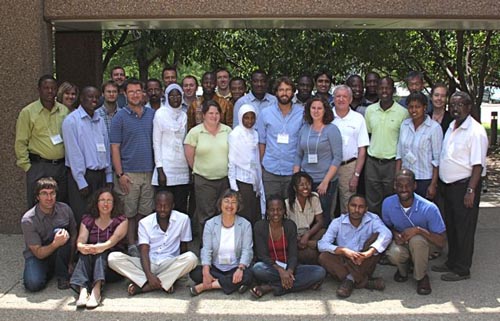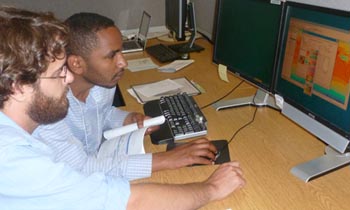NCAR colloquium looks at African weather and climate
Scholars from nine nations convene
Sep 7, 2011 - by Staff
Sep 7, 2011 - by Staff
Nicole Gordon | 7 September 2011 • A group of scholars and students from nine countries came together in Boulder this summer for two weeks of study dedicated to the world’s second largest and second most populous continent. The colloquium, “African Weather and Climate: Unique Challenges and Application of New Knowledge,” was hosted by NCAR’s Integrated Studies Program (ISP) from July 25 to August 5. It covered topics relevant to Africa as diverse as operational forecasting, numerical weather prediction, seasonal and regional climate, climate impacts, GIS, and health and disease.
Participants included 23 graduate students from the United States, Nigeria, Kenya, South Africa, Senegal, Ethiopia, Uganda, Ghana, and Nepal, and lecturers from the United States and Africa. Arlene Laing (NCAR) and Kerry Cook (University of Texas at Austin) co-chaired the colloquium, which included lectures, a poster session, hands-on exercises, and a field trip to an instrumented site in the Fourmile Canyon burn area.

Participants and instructors in the African weather and climate colloquium.
The colloquium was the first of its kind dedicated to African weather and climate. The idea originated at an AMMA (African Monsoon Multidisciplinary Analyses) conference held two years ago. “We wanted a way for students studying Africa to come together and collaborate, and at the time there weren’t many options,” says Laing, who proposed the workshop to ISP. “Because Africa presents so many interesting challenges for both research and applications, we need to get more people involved and take a more integrative and collaborative approach.”

Christopher Skinner (Stanford University) and Temesgen Gebremariam Asfaw (Addis Ababa University) confer during one of the colloquium's lab exercises. (Photo courtesy Arlene Laing.)
These challenges are the result of Africa’s unique land-ocean-atmosphere interactions, Laing says. The continent is a major source of tropical heating, hosts the planet’s second largest monsoon system, and experiences some of the largest and most intense thunderstorm complexes on Earth, some of which move into the Atlantic and evolve into hurricanes. It’s also the primary source of the mineral dust that swirls around the globe and is noted for extreme droughts as well as and floods.
“Understanding African climate and weather systems on all space and time scales is of vital importance to improve climate prediction for the region,” Cook says. “The continent’s climate can change rapidly, and the population is vulnerable.”
The colloquium focused on synthesizing knowledge of African weather and climate and applying modern tools (remote sensing, numerical simulation and prediction, statistical data analysis, and visualization) to understand variability on diurnal, synoptic, intraseasonal, interannual, and decadal time scales.
Graduate students who attended the colloquium cited networking and collaboration as the main draw. Mary-Jane Bopape, a graduate student at the University of Pretoria in South Africa, is working on the development of nonhydrostatic atmospheric models and model verification. “My main reason for attending the colloquium is to make connections in the field,” she said, adding that the lectures on model verification were particularly useful to her.
Vincent Otieno, who’s working on a doctorate at the University of Connecticut, is studying land use and climate variability in the Greater Horn of Africa. “I came to network and learn from people with knowledge of what I’m working on,” he said.
Matthew Janiga from the University at Albany–SUNY is looking at the life cycle of African easterly waves and developing forecasting models. The scarcity of observations over parts of Africa not only makes day-to-day prediction a challenge but also hinders the creation of frameworks for better understanding African weather. “Forecasting over Africa is difficult because we don’t have the conceptual models,” says Janiga, whose advisor at Albany, Chris Thorncroft, sat on the colloquium’s organizing committee and served as a lecturer.
The colloquium speakers reported that they too benefited from the workshop. “A number of lecturers sat in on other talks,” Laing says. “It was a chance for the community of researchers to connect with each other and learn from each other, as this many people studying African weather and climate haven’t come together in this fashion before.”
Andrew Githeko, chief research officer and head of the Climate and Human Health Research Unit at Kenya’s Centre for Global Health Research, reports that the colloquium was a valuable learning experience. “I can now interact with meteorologists in a much better way,” he says. “The knowledge I’ve gained will contribute toward the application of climate and weather in managing impacts.”
The African weather and climate colloquium was followed by the NSF Workshop on Science and Cyberinfrastructure in Africa on August 5–6, also held at NCAR to take advantage of the scientists and students already onsite for the colloquium.
As new fiber-optic cable systems enable Africa to connect to global research and education communities, interest is growing in building regional and national networks across the continent. The workshop took a close look at the cyberinfrastructure needs for greater collaboration between African and U.S. scientists
“I’ve been to three African countries and have experienced first hand how slow the network connections are,” Laing says. “It makes it especially difficult for African students and researchers to participate in virtual courses.”
The workshop brought together researchers and technicians from UCAR/NCAR, a number of African and American universities, the nonprofit Network Startup Resource Center, NOAA, and other organizations to discuss obstacles to better data networking capabilities in Africa, share experiences, and provide training.